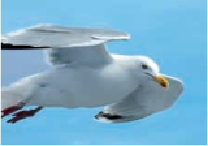Travel Reference
In-Depth Information
Oceanic Seabirds
Several Ryukyu Islands are home to seabird colonies. One of the most secluded is the marine bird
sanctuary on Nakanougan Islet, which holds a rich mix of species. There is no single taxonomic order
or class that contains seabirds. They come from a variety of families. But what they have in common is
adaptaion to life on the open ocean, only returning to shore to breed and raise their young. Oceanic
birds are different from most land species in that they feed in saltwater, possess webbed feet, have
salt glands that allow them to expel excess salt, have waterproof plumage and have a paricular wing
structure that either allows them to dive or, in the case of ocean-going pelagic species, glide over
great distances. Seabirds also difer dramaically from land birds in that they live much longer but re-
produce less frequently. They counter this by invesing far more in the care of their young. Ninety-ive
percent of seabirds form colonies, some of which contain millions of birds and thus consitute some
of the largest animal colonies on earth.
However, the real southernmost point of Japan is Okinotorishima (
沖ノ鳥島
; Okinotori-
shima; lit. “Offshore Remote Bird Island”), which is quite a bit further south at 20°25
ʹ
31
ʹ
North latitude; 136°04
ʹ
11
ʹ
East longitude. Since each degree of latitude is equal to about 69
miles (110 kilometers), Japan's true southernmost point is really 250 miles (400 kilometers)
further south of Hateruma.
Okinotori is an uninhabitable atoll and coral reef consisting of several, mostly sub-
merged, islets. It is approximately 335 miles (535 kilometers) southeast of Oki Daitō, 400
miles (635 kilometers) southwest of Iwo Jima of the Ogasawara Islands, and 1,085 miles
(1,750 kilometers) south of Tokyo. From another direction, the atoll is about 530 miles (850
kilometers) northwest above Guam and the Northern Marianas Islands. In English the reef
is known as “Parece Vela,” its original Spanish name (1565), which means “looks like a sail.”
The atoll is also known as “Douglas Reef” (1790) after William Douglas, a British sailor who
investigated these waters.
Essentially, the Parece Velas are miniscule reef islets held in order to bolster Japan's as-
sertion of fishing rights and seafloor exploration rights to potential oil and gas deposits. Al-

